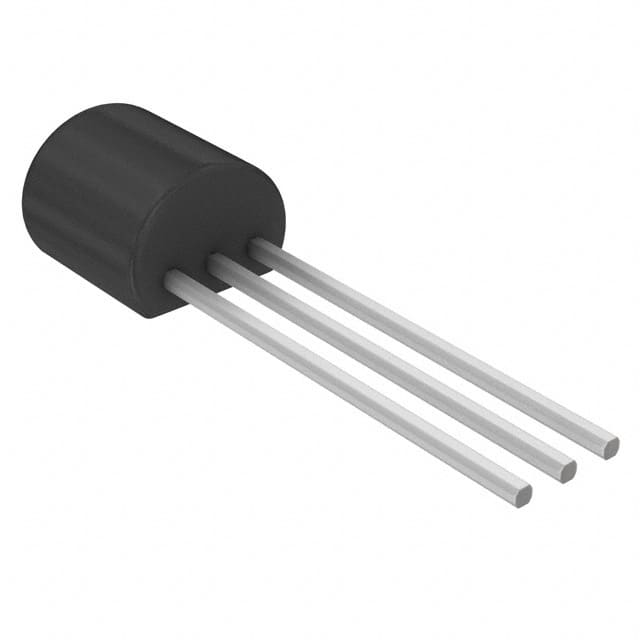Viz Specifikace pro podrobnosti o produktu.

PN4393 TRA
Product Overview
Category: Transistor
Use: Amplification and switching of electronic signals
Characteristics: Small signal N-channel JFET transistor
Package: TO-92
Essence: High input impedance, low noise, and high gain
Packaging/Quantity: Typically available in reels of 2000 units
Specifications
- Maximum Drain-Source Voltage (Vds): 30V
- Maximum Gate-Source Voltage (Vgs): 30V
- Maximum Continuous Drain Current (Id): 35mA
- Maximum Power Dissipation (Pd): 350mW
- Transconductance (gm): 4mS
Detailed Pin Configuration
- Gate (G)
- Drain (D)
- Source (S)
Functional Features
- High input impedance
- Low noise
- High gain
- Suitable for low-power applications
Advantages and Disadvantages
Advantages: - High input impedance allows for minimal loading of the signal source - Low noise makes it suitable for low-level audio amplification - High gain enables signal amplification without significant distortion
Disadvantages: - Limited maximum drain-source voltage and current may restrict its use in certain high-power applications
Working Principles
The PN4393 TRA operates based on the field-effect transistor (FET) principle, where the flow of current between the drain and source terminals is controlled by the voltage applied to the gate terminal. It amplifies electronic signals by modulating the conductivity of a channel in the semiconductor material.
Detailed Application Field Plans
- Low-Level Audio Amplification: The low noise and high gain characteristics make the PN4393 TRA suitable for amplifying low-level audio signals in applications such as microphone preamplifiers and audio mixers.
- Sensor Signal Conditioning: Its high input impedance and low noise make it ideal for conditioning signals from sensors in various electronic systems.
- Oscillator Circuits: The PN4393 TRA can be used in oscillator circuits due to its high input impedance and ability to generate stable oscillations.
Detailed and Complete Alternative Models
- 2N5457: Similar small signal N-channel JFET transistor with comparable characteristics
- J201: Another alternative with similar specifications and package type
Note: The provided alternatives are based on similar category, use, and characteristics.
This comprehensive entry provides an in-depth understanding of the PN4393 TRA, covering its basic information, specifications, functional features, advantages and disadvantages, working principles, application field plans, and alternative models.
Seznam 10 běžných otázek a odpovědí souvisejících s aplikací PN4393 TRA v technických řešeních
Sure, here are 10 common questions and answers related to the application of PN4393 TRA in technical solutions:
What is PN4393 TRA?
- PN4393 TRA is a type of field-effect transistor (FET) commonly used in electronic circuits for switching and amplification purposes.
What are the key specifications of PN4393 TRA?
- The key specifications of PN4393 TRA include a maximum drain-source voltage of 30V, a continuous drain current of 350mA, and a low threshold voltage.
How can PN4393 TRA be used in switching applications?
- PN4393 TRA can be used as a switch to control the flow of current in electronic circuits by applying a voltage to the gate terminal, allowing it to act as an on/off switch.
In what types of amplification circuits can PN4393 TRA be used?
- PN4393 TRA can be used in small-signal amplification circuits where low power and high input impedance are required.
What are the typical applications of PN4393 TRA in technical solutions?
- PN4393 TRA is commonly used in audio amplifiers, signal processing circuits, and low-power switching applications.
What are the advantages of using PN4393 TRA in technical solutions?
- The advantages of using PN4393 TRA include its low threshold voltage, high input impedance, and compatibility with low-voltage circuits.
How should PN4393 TRA be properly biased in a circuit?
- PN4393 TRA should be biased to operate within its specified voltage and current limits to ensure proper functionality and reliability in the circuit.
Can PN4393 TRA be used in high-frequency applications?
- PN4393 TRA is not typically recommended for high-frequency applications due to its relatively limited frequency response.
What are the important considerations when designing a circuit with PN4393 TRA?
- Important considerations include ensuring proper biasing, understanding the voltage and current limitations, and minimizing noise and interference in the circuit.
Are there any alternative components that can be used in place of PN4393 TRA?
- Yes, alternative FETs with similar characteristics, such as JFETs or MOSFETs, can be considered based on specific circuit requirements.
These questions and answers provide a comprehensive overview of the application of PN4393 TRA in technical solutions.

